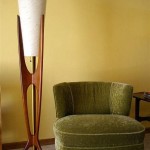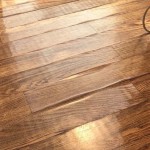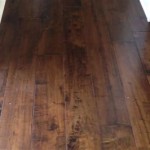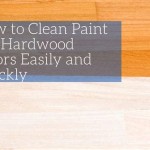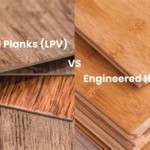Water-Based Wood Floor Finishes: An Overview
Water-based wood floor finishes have emerged as a prominent alternative to traditional oil-based finishes, gaining popularity among homeowners and professionals alike. These finishes, characterized by their water-based composition, offer a distinct set of advantages and considerations that differentiate them from their oil-based counterparts. Understanding the properties, application, and performance characteristics of water-based finishes is crucial for making informed decisions regarding wood floor finishing projects.
This article provides a comprehensive overview of water-based wood floor finishes, exploring their composition, advantages, disadvantages, application methods, and maintenance requirements. The goal is to equip readers with the knowledge necessary to evaluate the suitability of water-based finishes for their specific needs and to achieve optimal results when using them.
Composition and Chemistry
The primary distinction between water-based and oil-based wood floor finishes lies in their solvent base. Water-based finishes use water as the primary solvent, while oil-based finishes utilize petroleum-based solvents. The water-based formulation consists of a blend of acrylic polymers, polyurethane resins, coalescents, and other additives dispersed in water. These components work in concert to create a durable and protective coating on the wood surface.
The acrylic polymers provide hardness and scratch resistance, while the polyurethane resins contribute to flexibility and impact resistance. Coalescents are added to facilitate the formation of a continuous film as the water evaporates. These additives help the polymers fuse together, creating a uniform and robust coating. The specific composition of a water-based finish can vary depending on the manufacturer and the intended application.
The volatile organic compound (VOC) content is a significant factor differentiating water-based and oil-based finishes. VOCs are organic chemicals that evaporate at room temperature and can contribute to air pollution and health concerns. Water-based finishes generally have significantly lower VOC emissions compared to oil-based finishes, making them a more environmentally friendly and healthier option.
The curing process for water-based finishes involves the evaporation of water and the subsequent cross-linking of the polymers. This cross-linking process, often aided by oxygen or UV light, creates a strong and durable film. The curing time can vary depending on the specific product, ambient temperature, humidity, and the number of coats applied.
Advantages of Water-Based Finishes
Water-based wood floor finishes offer several advantages that contribute to their growing popularity. These advantages span environmental considerations, application properties, and aesthetic qualities.
Lower VOC Emissions: As previously mentioned, the low VOC content is a major advantage. This contributes to improved indoor air quality and reduced environmental impact. This factor is particularly important for individuals with sensitivities to chemicals or those concerned about the environmental consequences of their choices.
Faster Drying Time: Water-based finishes typically dry much faster than oil-based finishes. This allows for quicker project completion and reduced downtime. Multiple coats can often be applied in a single day, minimizing disruption to the household or business.
Clearer Finish: Water-based finishes tend to provide a clearer, more transparent finish compared to oil-based finishes, which can impart an amber or yellowish hue to the wood. This allows the natural color and grain of the wood to shine through, creating a more natural and contemporary look. This is especially desirable for lighter-colored woods or when a minimalist aesthetic is preferred.
Non-Flammable: Due to their water-based composition, these finishes are non-flammable, reducing the risk of fire during application and storage. This safety aspect makes them a preferred choice for many contractors and homeowners.
Easy Cleanup: Cleanup is significantly easier with water-based finishes. Soap and water are typically sufficient for cleaning brushes, rollers, and other equipment. This simplifies the overall finishing process and reduces the need for harsh solvents.
Resistance to Yellowing: Unlike oil-based finishes, water-based finishes are less prone to yellowing over time. This helps to maintain the original color and appearance of the wood floor for a longer period.
Disadvantages and Considerations
While water-based finishes offer numerous advantages, it is essential to acknowledge their potential drawbacks and considerations before making a selection.
Higher Cost: Water-based finishes generally tend to be more expensive than oil-based finishes. This cost difference should be factored into the overall budget for the flooring project. However, the long-term benefits, such as lower VOC emissions and reduced maintenance, may offset the initial higher cost.
Grain Raising: Water-based finishes can sometimes cause the wood grain to raise, creating a slightly rough texture. This can be mitigated by lightly sanding the floor between coats.
Durability Concerns (Historically): Early formulations of water-based finishes were sometimes perceived as less durable than oil-based finishes. However, advancements in technology have significantly improved the durability of modern water-based finishes, making them comparable to or even exceeding the performance of some oil-based options. It is important to select a high-quality water-based finish from a reputable manufacturer to ensure optimal durability.
Application Technique: Proper application technique is crucial for achieving a satisfactory result with water-based finishes. The finish needs to be applied evenly and consistently to avoid streaks or lap marks. Experienced applicators may be needed to achieve the best outcomes, especially on large or complex flooring projects.
Shorter Open Time: Water-based finishes often have a shorter open time compared to oil-based finishes. This means that the finish dries more quickly, requiring faster application and blending to avoid visible overlaps. This can be more challenging for less experienced applicators.
Potential for Lapping: Due to the faster drying time, lapping (visible lines where the finish overlaps) can be more of a problem with water-based finishes if not applied carefully and quickly.
Application Methods and Best Practices
The successful application of water-based wood floor finishes depends on proper preparation, the correct tools, and adherence to best practices. Following these guidelines will help to ensure a durable and aesthetically pleasing result.
Surface Preparation: The floor must be thoroughly sanded to a smooth and even surface. All traces of previous finishes, waxes, or contaminants must be removed. This is arguably the most crucial step, as any imperfections in the surface will be magnified by the finish.
Acclimation: Allow the finish to acclimate to the room temperature before application. This will help to ensure proper flow and adhesion.
Application Tools: Use high-quality applicators specifically designed for water-based finishes, such as synthetic brushes or microfiber rollers. Avoid using natural bristle brushes, as they can absorb water and swell, leading to uneven application.
Application Technique: Apply the finish in thin, even coats, following the grain of the wood. Avoid applying too much finish at once, as this can lead to drips and runs. Maintain a wet edge to prevent lapping.
Number of Coats: Apply at least two to three coats of finish, allowing each coat to dry completely before applying the next. Lightly sand between coats with a fine-grit sandpaper to remove any imperfections and ensure proper adhesion.
Drying Time: Allow the finish to dry completely according to the manufacturer's instructions. Avoid walking on the floor until it is fully cured. Curing times can vary, so it is essential to follow the manufacturer's recommendations.
Ventilation: Ensure adequate ventilation during application and drying to facilitate the evaporation of water and promote proper curing.
Sealers and Primers Consider using a compatible sealer or primer before applying the finish, especially on porous woods. This can help to improve adhesion, reduce grain raising, and enhance the final appearance.
Testing: Before applying the finish to the entire floor, test it in an inconspicuous area to ensure compatibility and desired results. This allows for adjustments to the application technique or product selection if necessary.
Understanding the nuances of water-based wood floor finishes is essential for achieving optimal results. By considering the composition, advantages, disadvantages, and proper application techniques, informed decisions can be made to ensure a beautiful and durable floor that meets specific needs and preferences.

Water Based Finish To A Wood Floor For More Natural Look

Top 3 Hardwood Floor Finishes How To Choose Carlisle Wide Plank Floors

Water Based Vs Oil Floor Finish Pros And Cons

Oil Based Vs Water Duane S Floor Service Inc

Minwax Ultimate Floor Finish 2 Pack Water Based Clear Transpa Gloss Interior Stain 1 Gallon 131010000sos At Com

Varathane 298273 Ultra Thick Floor Finish Semi Gloss Gal

Oil Based Vs Water Floor Finish Chicago Floorecki Llc Flooring Installation Hardwood Floors Installations Repairs And Stairs Services In

How Long Does Water Based Polyurethane Take To Dry Elephant Floors

Water Based Vs Oil Polyurethane Floor Finish Our Aesthetic Abode

Why Floor Water Based Polyurethane Is A Game Changer Professional Coatings Inc


